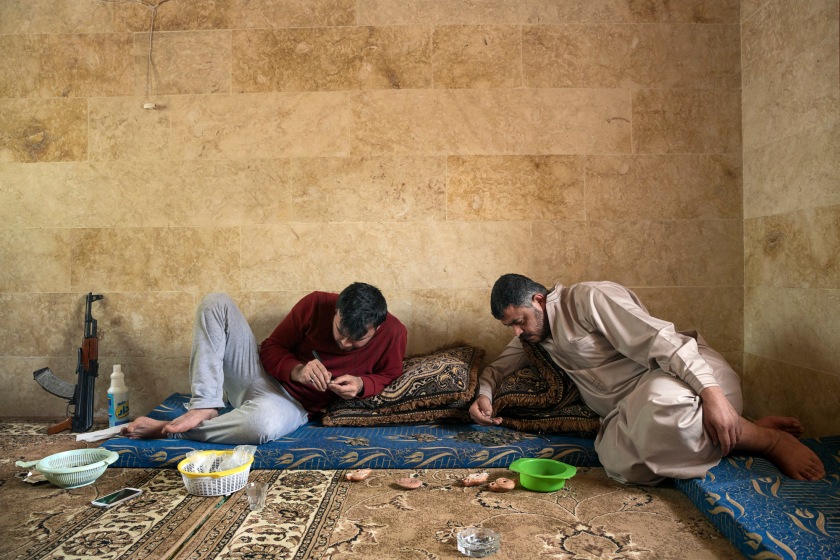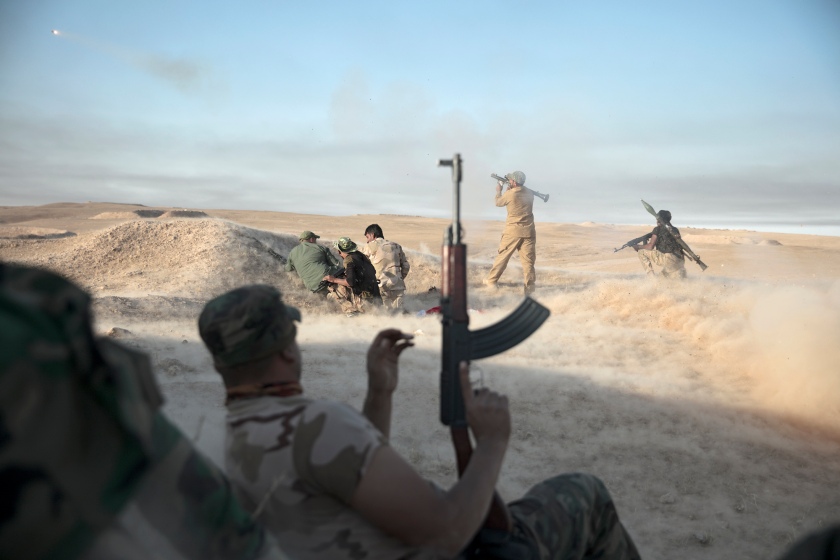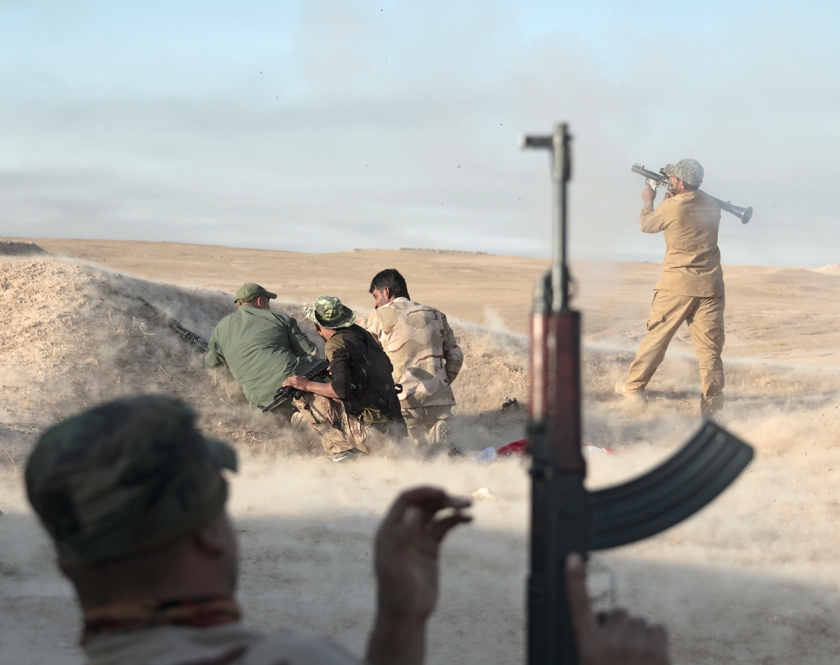Exhibition dates: 17th October 2018 – 27th January 2019
Curator: Lydia Dorner, Curator Assistant, Musée de l’Elysée
Matthias Bruggmann (Swiss born France, b. 1978)
Marmarita, Reef Homes, September 11 2013
2013
© Matthias Bruggmann / Contact Press Images
Courtesy Musée de l’Elysée, Lausanne and Galerie Polaris, Paris
“The swimming pool at Al-Khair Hotel, above Marmarita. A number of the young men are from the Christian militia that protects Marmarita and helps besiege both the Krak des Chevaliers and al Husn, the Sunni village built around it. The Krak fell to the Syrian army in March 2014. Reuters, quoting Lebanese medical sources, reported that over forty of the opposition fighters fleeing the area were wounded in an ambush on the way out, with eight dead.”
These magnificent, thought provoking photographs by Swiss photographer Matthias Bruggmann take a critical look at the representation of the atrocities of war. The photographs won the Prix Elysée in 2017, awarded by the Musée de l’Elysée.
The photographs picture everyday life in what Bangladeshi photographer Shahidul Alam has so aptly referred to as the “majority world” – that is, they attend to issues of critical importance in Asia, the Middle East, Africa, Latin America and Oceania… not Europe or America. They shine a light on the conflict that is taking place in Syria and the surrounding geographical area by offering an outsiders perspective, much as Robert Frank offered an outsiders perspective on American society as he travelled through the USA, the resultant photographs leading to the production of his famous book The Americans.
But here the stakes are much higher. Here, life hangs in the balance. The little girl with the blond hair balances on her father’s shoulders; a man in silhouette peers through his night scope while the stars of the cosmos hang in the night sky behind; a man fires his machine pistol by holding it above his head, his comrades sheltering behind rocks; while a young man sits on his haunches, hunched over, blindfolded, bruised and in handcuffs. Awaiting some unknown fate.
One image among these formal, classical photographs (a body of work which crosses over from photojournalism to contemporary artistic photography) is particularly disturbing. On the road, Iraq, September 24 2016 (below) shows a group of men much like the groups of men that can be seen in Baroque painting. One man addresses the viewer holding a mobile phone, his face a skeleton, mask; another four men hold mobile phones in various attitudes, recording the scene or looking into them; the man at left, with a gun thrusting down his leg, walks into the scene, while the one behind walks out of scene, left; in the distance at right, a machine gun is mounted on a tripod, with man walking out of scene, right; while at centre right a group of four men, one with a Union Jack flag on the crutch of his trousers (?!), gaze down at a recumbent figure, a figure that you don’t initially see when looking at the photograph, for every man is standing but for the blood soaked figure of death.
The photograph highlights the barrenness of the landscape and the symbolical values embedded in the scene (masculinity, war, guns, flags, mobile phones, bodies, attitudes, death), clues in a charade which the spectator solves volens nolens – unwilling (or) willing: like it or not. The truth is yelled at you, if you know how to interpret the symbols.
It’s the mundanity evidenced in most of these mise en scène that gets you in the guts, that stirs up my anger and feelings of sadness and regret. I am so over ugly, male energy, from whichever side, from wherever – used in the name of religion, nationalism, power and control – to rule the life of others. These photographs are like a sad lament, a prayer offered up to the human race to ask deliverance from distress, suffering, and pain. Indifference to the pain and suffering of others should not be an option, for “in difference”, “we look with respect to another culture or another people.” (Mr Massarwe)
Dr Marcus Bunyan
Many thankx to the Musée de l’Elysée for allowing me to publish the photographs in the posting. Please click on the photographs for a larger version of the image.
Matthias Bruggmann (Swiss born France, b. 1978)
Reef Idlib, February 20, 2013
2013
© Matthias Bruggmann / Contact Press Images
Courtesy Musée de l’Elysée, Lausanne and Galerie Polaris, Paris
“Two men mourn their brother who died decapitated by a regime shell. The fear of bombings was such that families stopped organising large funerals.”
Matthias Bruggmann (Swiss born France, b. 1978)
On the road, Iraq, September 24 2016
2016
© Matthias Bruggmann / Contact Press Images
Courtesy Musée de l’Elysée, Lausanne and Galerie Polaris, Paris
Matthias Bruggmann (Swiss born France, b. 1978)
Reef Idlib, 3 May 2014
2014
© Matthias Bruggmann / Contact Press Images
Courtesy Musée de l’Elysée, Lausanne and Galerie Polaris, Paris
“Using toilet cleaner and a dental probe, middlemen clean ancient coins. Coins and other antiquities are exported throughout the region, mostly to Turkey, but also Lebanon and, in some cases, Jordan, from where silver shekels then make their way to the Jerusalem souvenir industry. The trickiest part is faking provenance so that the antiquities can enter the highly lucrative Western market – dealers in neighbouring countries would take a fifty percent cut on the sale for the procurement. The asking price for a Byzantine mosaic measuring around two square meters was between 1,500 and 2,000 dollars and smuggling it out to a neighbouring country cost around 4,000 dollars at that point. Many of the deals were carried out over WhatsApp, and Syrians were often double-crossed by unscrupulous foreign dealers. One of the men in this photograph later complained that a North American dealer had cost him a small fortune when he refused to pay up his share.”
Matthias Bruggmann (Swiss born France, b. 1978)
Reef Idlib, 3 May 2014 (detail)
2014
© Matthias Bruggmann / Contact Press Images
Courtesy Musée de l’Elysée, Lausanne and Galerie Polaris, Paris
Matthias Bruggmann (Swiss born France, b. 1978)
Talmenes Reef Idlib 1 mai 2014
2014
© Matthias Bruggmann / Contact Press Images
Courtesy Musée de l’Elysée, Lausanne and Galerie Polaris, Paris
“The remains of a barrel of chlorine (Cl₂) that was dropped on a house from a helicopter. This is one of the hundred or so documented attacks using chemical agents that happened before and after the 2013 Ghouta bombings in Damascus that the United States estimates killed 1,429. The Syrian government was the only warring faction to have access to airpower, therefore it is unthinkable that anyone else dropped this barrel. A man who refused to give his name, presenting himself as the owner of the house and the father of two of the children killed in the bombing, explained that he was an employee of a government-run granary. When he went back to work, he said, men came and offered him to interview him on an official TV channel to say that Jabhat al-Nusra had dropped the bomb. He added that the men offered to give him money to rebuild his house in exchange. This attack, which killed 3 and wounded over 130, was extensively documented, both by Human Rights Watch and by Christoph Reuter in Germany’s Der Spiegel. As of mid-2018, the Syrian Archive also held over a dozen videos of the attack and its aftermath.”
Matthias Bruggmann (Swiss born France, b. 1978)
Kafr Souseh, Damascus, 5 May 2012
2012
© Matthias Bruggmann / Contact Press Images
Courtesy Musée de l’Elysée, Lausanne and Galerie Polaris, Paris
Matthias Bruggmann (Swiss born France, b. 1978)
Desert, 20 September 2016
2016
© Matthias Bruggmann / Contact Press Images
Courtesy Musée de l’Elysée, Lausanne and Galerie Polaris, Paris
Matthias Bruggmann (Swiss born France, b. 1978)
Desert, 20 September 2016 (detail)
2016
© Matthias Bruggmann / Contact Press Images
Courtesy Musée de l’Elysée, Lausanne and Galerie Polaris, Paris
Matthias Bruggmann (Swiss born France, b. 1978)
Shinshirah, Reef Idlib, 19 May 2014
2014
© Matthias Bruggmann / Contact Press Images
Courtesy Musée de l’Elysée, Lausanne and Galerie Polaris, Paris
Matthias Bruggmann (Swiss born France, b. 1978)
Shinshirah, Reef Idlib, 19 May 2014 (detail)
2014
© Matthias Bruggmann / Contact Press Images
Courtesy Musée de l’Elysée, Lausanne and Galerie Polaris, Paris
Matthias Bruggmann is the winner of the second edition of the Prix Elysée, with the support of Parmigiani Fleurier, for his project on Syria. Hoping to “bring, to Western viewers, a visceral comprehension of the intangible violence that underlies conflict”, he takes the gamble of hiding nothing in his explicit and brutal pictures. Taken in the field, they force the viewer to slow down and take stock of the war – geographically distant, admittedly, but made omnipresent by the media.
If the tens of thousands of pictures of torture taken by Syrian photographers do not attract the attention of a Western audience, what can a foreigner who doesn’t even speak Arabic hope to accomplish? The photographs of Matthias Bruggmann take a critical look at the representation of the atrocities of war. They give Westerners a more nuanced picture of the reality of an armed conflict and blur the boundaries between photojournalism and contemporary artistic photography.
Launched in 2012, his project plunges us into the complexity of the conflict. His images, which cover a geographic zone larger than Syria, question our moral assumptions and bring about a better understanding of the violence underlying this conflict.
Matthias Bruggmann explains: “Formally, my previous work put viewers in a position where they were asked to decide the nature of the work itself. A scientifically questionable analogy of this mechanism would be the observer effect in quantum physics, where the act of observing changes the nature of what is being observed. My Syrian work builds on this framework. From a documentation perspective, it is, thus far and to the best of my knowledge, unique as the work, inside Syria, of a single Western photographer, in large part thanks to the assistance and hard work of some of the best independent experts on the conflict. Because of the nature of this conflict, I believe it is necessary to expand the geographical scope of the work. At its core is an attempt at generating a sense of moral ambiguity. The design of this is to make viewers uneasy by challenging their own moral assumptions and, thus, attempt to bring, to Western viewers, a visceral comprehension of the intangible violence that underlies conflict. One of the means is by perverting the codes normally used in documentary photography to enhance identification with the subject.”
Biography
Matthias Bruggmann is a Swiss photographer who was born in Aixen-Provence in 1978. For the past 15 years, his work has focused on the different war zones throughout the world. After graduating from the Vevey School of Photography in 2003, he became interested very early on in the complexity of his profession in times of war. At the beginning of the 2000s, he accompanied the photojournalist Antonin Kratochvil, who covered the invasion of Iraq. This first experience provided him with the opportunity to explore the complex link between photojournalism and reality – what is actually grasped or described. Since that time, his personal projects have taken him to Egypt, Haiti, Libya and Somalia.
Matthias Bruggmann’s work was featured in the exhibition reGeneration: 50 photographers of tomorrow, organised by the Musée de l’Elysée in 2005, and he was part of the curatorial team for We Are All Photographers Now! presented at the museum in 2007. He is also one of the cofounders of the contemporary art space, Standard / Deluxe, in Lausanne. His photographs have been published in countless newspapers and magazines, including Le Monde, The Sunday Times, Time Magazine and National Geographic.
His work is included in a number of private collections, as well as the public collections of the Frac Midi-Pyrénées and the Musée de l’Elysée. His project on Syria received the Prix Elysée in 2017, awarded by the Musée de l’Elysée with the support of Parmigiani Fleurier. He is represented by the Contact Press Images agency and by the Galerie Polaris in Paris.
Press release from the Musée de l’Elysée website
Matthias Bruggmann (Swiss born France, b. 1978)
Shirqat, Iraq, 22 September 2016
2016
© Matthias Bruggmann / Contact Press Images
Courtesy Musée de l’Elysée, Lausanne and Galerie Polaris, Paris
Matthias Bruggmann (Swiss born France, b. 1978)
Shirqat, Iraq, 22 September 2016 (detail)
2016
© Matthias Bruggmann / Contact Press Images
Courtesy Musée de l’Elysée, Lausanne and Galerie Polaris, Paris
Matthias Bruggmann (Swiss born France, b. 1978)
Ghazi Ayaash, Deir ez-Zor, May 25, 2015
2015
© Matthias Bruggmann / Contact Press Images
Courtesy Musée de l’Elysée, Lausanne and Galerie Polaris, Paris
Matthias Bruggmann (Swiss born France, b. 1978)
Rabiah, Reef Hama, April 23, 2012
2012
© Matthias Bruggmann / Contact Press Images
Courtesy Musée de l’Elysée, Lausanne and Galerie Polaris, Paris
Matthias Bruggmann (Swiss born France, b. 1978)
Hadar, Reef Quneitra, August 7, 2015
2015
© Matthias Bruggmann / Contact Press Images
Courtesy Musée de l’Elysée, Lausanne and Galerie Polaris, Paris
At the northern frontline between the Druze fighters and Jabhat al-Nusra, the older fighters teach the younger ones how to fight. Some of the fighters were in the security services, and either retired, or went absent without leave to defend their village.
Matthias Bruggmann (Swiss born France, b. 1978)
Bab Hud, Homs, May 26, 2012
2012
© Matthias Bruggmann / Contact Press Images
Courtesy Musée de l’Elysée, Lausanne and Galerie Polaris, Paris
Syria, 2012. In the old town of Homs, a group of fighters and activists meet to stage an allegorical piece written by one of them, who was, in his life, before the revolution, a known writer. In this piece, a lion (or assad, in Arabic…) has lost his voice, and mistreats the other animals to try to find it. The street next door is one of the most dangerous in the city, because it is the corner of government shooters.
Matthias Bruggmann (Swiss born France, b. 1978)
Bab Hud, Homs, May 26, 2012 (detail)
2012
© Matthias Bruggmann / Contact Press Images
Courtesy Musée de l’Elysée, Lausanne and Galerie Polaris, Paris
Matthias Bruggmann (Swiss born France, b. 1978)
Industrial City, Deir ez-Zor, May 5, 2015
2015
© Matthias Bruggmann / Contact Press Images
Courtesy Musée de l’Elysée, Lausanne and Galerie Polaris, Paris
Matthias Bruggmann (Swiss born France, b. 1978)
Shirqat, Iraq, September 22, 2016
2016
© Matthias Bruggmann / Contact Press Images
Courtesy Musée de l’Elysée, Lausanne and Galerie Polaris, Paris
The Musée de l’Elysée
18, avenue de l’Elysée
CH - 1014 Lausanne
Phone: + 41 21 316 99 11
Opening hours:
Tuesday – Sunday, 10am – 6pm
Closed Monday, except for bank holidays





















You must be logged in to post a comment.